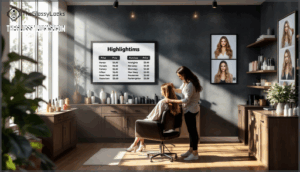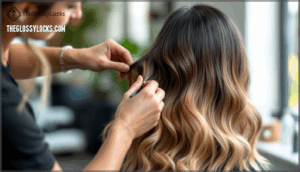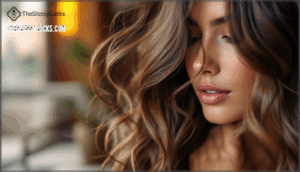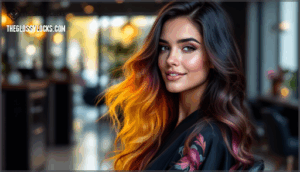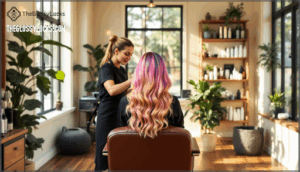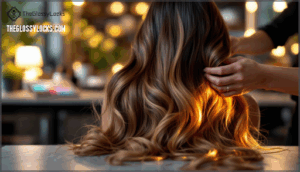This site is supported by our readers. We may earn a commission, at no cost to you, if you purchase through links.
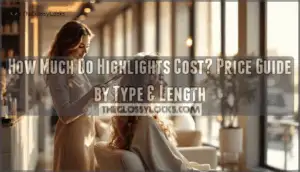 Highlights can run anywhere from $60 at a budget salon to $400+ at a high-end studio—and that price gap isn’t arbitrary. Your final bill hinges on technique, hair length, your colorist’s reputation, and where you live. Foil highlights work differently than balayage, short hair requires less product than long, and a senior stylist in Manhattan won’t charge the same as a junior colorist in rural Ohio.
Highlights can run anywhere from $60 at a budget salon to $400+ at a high-end studio—and that price gap isn’t arbitrary. Your final bill hinges on technique, hair length, your colorist’s reputation, and where you live. Foil highlights work differently than balayage, short hair requires less product than long, and a senior stylist in Manhattan won’t charge the same as a junior colorist in rural Ohio.
Before you book, you need to understand what drives these costs and which variables you can actually control. Here’s how to decode salon pricing so you walk in prepared—not surprised when the receptionist hands you the total.
Table Of Contents
- Key Takeaways
- What Are Hair Highlights?
- What Affects The Cost of Highlights?
- How Much Do Different Highlight Types Cost?
- How Does Hair Length Impact Price?
- How Does Salon Location Change Costs?
- How Does Stylist Experience Affect Pricing?
- What Additional Services Raise The Total Cost?
- How Much Does Maintenance Cost?
- How Can You Save Money on Highlights?
- Are Salon Highlights Worth The Investment?
- Frequently Asked Questions (FAQs)
- How long does the highlighting process take?
- What is the best way to maintain highlights?
- Are highlights damaging to the hair?
- What are the expected results of highlights?
- Are there any special techniques used for creating highlights?
- Can you highlight previously colored or dyed hair?
- How much does color correction for highlights cost?
- Do highlights damage hair more than regular coloring?
- How long do highlights typically last before fading?
- Whats the difference between highlights and all-over bleaching?
- Conclusion
Key Takeaways
- Highlight costs range from $60 at budget salons to $400+ at high-end studios, with your final bill determined by technique (foil vs. balayage), hair length, stylist experience, and geographic location—understanding these drivers lets you control what you pay instead of getting blindsided at checkout.
- Different highlighting methods carry distinct price points: foil highlights run $75-$150, balayage costs $150-$450, babylights range from $55-$350, and maintenance intervals vary from 8-12 weeks for traditional highlights to 12-16 weeks for balayage, making technique choice crucial for both upfront and ongoing costs.
- Location dramatically impacts pricing, with North Dakota topping national averages at $270 per session while Montana bottoms out at $65, and urban salons charging $150-$300+ compared to rural shops at $75-$150 due to rent, competition, and overhead differences.
- Professional highlights justify their cost through longevity (8-12 weeks vs. DIY’s 4-6 weeks), damage prevention, and expertise that avoids color correction disasters—about 1 in 10 DIY attempts require professional fixes costing $100-$250 extra, erasing any initial savings from $7-$45 box kits.
What Are Hair Highlights?
If you’re ready to shake up your look, highlights might be your ticket to that fresh, dimensional style you’ve been craving. Before you book that chair, you’ll want to know what you’re getting into—both style-wise and budget-wise.
Let’s break down what highlights actually are, how they work, and why they’re different from a full color overhaul.
Definition and Purpose
Highlights are strategically lightened sections of hair designed to add depth, dimension, and natural-looking contrast to your overall color—basically, they’re the secret weapon that turns flat, one-note hair into something that catches the light and turns heads. These hair coloring techniques work with your natural looks and hair texture to create color enhancement that doesn’t scream "I just left the salon." The purpose of hair highlights goes beyond aesthetics:
- Dimension: Highlights break up solid color with varied tones that mimic how sunlight naturally lightens hair
- Customization: Hair highlighting techniques let you control placement, intensity, and tone based on your hair color theory preferences
- Low-Maintenance Drama: Strategic highlight techniques grow out more gracefully than all-over color, giving you freedom between appointments
Common Highlighting Methods
Once you’ve decided highlights are the move, choosing the right application method becomes your next power play—and each technique delivers its own brand of dimension, maintenance level, and price tag.
Foil techniques use structured weaving and color placement for precise, dramatic contrast. Balayage methods involve freehand hair painting that sweeps lightener onto hair for lived-in, low-maintenance dimension. Babylights replicate the delicate, sun-kissed strands of childhood through micro-fine foil work, while cap highlighting pulls hair through perforations for even distribution—each method reshaping both your look and your hair highlighting costs.
Differences From All-Over Color
While highlights add strategic light and shadow, all-over color floods your entire head with one shade—the difference between sculpting dimension and applying a flat coat of paint. Highlights create tonal variation through selective highlight placement, while single-process color delivers uniform coverage without dimensional color or natural look authenticity.
Key contrasts:
- Color contrast: Highlights weave light through dark; all-over color eliminates contrast entirely
- Hair highlighting costs: Balayage and foil techniques demand more time and skill than flat application
- Maintenance: Dimensional color grows out softer than harsh demarcation lines from salon services and pricing structures
What Affects The Cost of Highlights?
You’re not walking into that salon blind—you deserve to know exactly what drives the final number on your bill. Several key factors determine whether you’ll pay $75 or $400 for your highlights, and understanding them puts you in control.
Let’s break down the three main elements that shape your cost.
Hair Length and Thickness
Your hair length and thickness don’t just determine how much product your stylist needs—they directly dictate how much time you’ll spend in that chair and how deep you’ll dig into your wallet. Long, thick hair demands more foils for full highlights, more bleach, and considerably more labor than a pixie cut.
Hair volume and thickness impact everything—from partial highlights on shoulder-length locks to complete transformations on waist-length manes, where style effects and cut influence can double or triple your final bill.
Starting Hair Color
Darker base colors require more lifting power—and that means more bleach sessions, more time under the dryer, and a heftier price tag than blondes usually face. During your initial consultation, your colorist evaluates color theory and base shades to determine how many sessions you’ll need for natural looks.
Here are some key considerations:
- Virgin dark hair often costs 20-40% more than previously lightened hair
- Red tones resist lifting and may require extra bleach applications
- Gray coverage combined with highlights adds complexity—especially for balayage and hair coloring techniques
Highlight Placement and Density
The more strands your colorist touches, the deeper they’ll need to reach into your wallet. Partial highlights around your face cost 40-60% less than full-head coverage.
Balayage with soft, hand-painted placement strategies runs cheaper than dense babylights requiring precise hair sectioning.
Lowlights mixed with highlights add dimension—and dollars—through complex color distribution and weaving techniques that demand serious density control skills.
How Much Do Different Highlight Types Cost?
Not all highlights are created equal—and neither are their price tags. The technique your stylist uses makes a huge difference in what you’ll pay at checkout.
Here’s what you can expect to spend on each popular highlighting method.
Foil Highlights
If you want that classic, dimensional look with maximum control over where color goes, foil highlights deliver precision like nothing else. Your stylist uses hair sectioning to isolate strands, then applies color exactly where you want it—whether that’s face-framing pieces or all-over brightness.
Foil placement wraps each section, locking in heat to lift color faster.
Expect to pay $75 to $150 for full foil highlights, with highlight maintenance every 8–12 weeks keeping your look fresh.
Balayage
Balayage is where your colorist becomes an artist—hand-painting lightness into your hair without foils, lines of demarcation, or that "I just got highlights" vibe. This hair painting technique creates color dimension that grows out gracefully, meaning highlight maintenance stretches to 12–16 weeks instead of constant touch-ups.
Balayage highlights deliver those coveted natural looks with sun-kissed depth. Expect to invest $150 to $450, depending on your hair length and the stylist’s balayage techniques.
Babylights
Think of babylights as the whisper version of traditional highlights—micro-fine strands so delicate they mimic the sun-bleached hair you’d have as a kid running wild outdoors.
The babylight technique demands precision highlight placement with ultra-thin weaving, creating smooth hair color that adapts beautifully to your hair texture.
This careful hair coloring techniques and methods approach ranges from $55 to $350, with color maintenance easier since regrowth blends invisibly into your base.
Lowlights
Lowlights flip the script by weaving darker tones into your hair, adding depth and richness where highlights would brighten. This hair contouring technique creates dimensional color through subtle layers that work like shadows, giving you tonal balance and natural depth most hair highlights can’t achieve alone.
Lowlights generally cost:
- Partial lowlights: $45–$90
- Full lowlights: $75–$150
- Combined with highlights: $100–$250
- Correction work: $150–$300+
- Maintenance visits: Every 10–14 weeks
Ombré
Ombré takes that shadow-to-light concept and cranks it up, delivering a dramatic color fade that starts dark at your roots and melts into lighter ends—no subtlety required. This hair painting technique creates color gradation that’s bolder than balayage or subtle highlights, giving you dimensional looks without constant root maintenance.
| Service Type | Price Range |
|---|---|
| Standard ombré | $150–$250 |
| Vivid color ombré | $200–$400 |
| Correction/redo | $250–$500+ |
| Maintenance (8–12 weeks) | $100–$200 |
How Does Hair Length Impact Price?
Your hair length doesn’t just affect how you style it—it directly impacts how much you’ll pay for highlights. Longer hair requires more product, more time in the chair, and often more intricate work to achieve flawless results.
Here’s how stylists usually break down pricing based on whether you’re rocking a pixie cut or waist-length waves.
Short Vs. Medium Vs. Long Hair
Your hair length isn’t just about looks—it’s the biggest driver of your final bill at the salon. Short hair usually runs $75 to $150 for full hair highlights since less product and time are needed. Medium-length hair pushes that to $100 to $200, factoring in color depth and texture matters. Long hair? You’re looking at $150 to $300 or more, especially if your styling needs include balayage or full coverage.
Salon services and prices scale with every inch, affecting both hair highlight costs and hair care maintenance down the line.
Product Usage and Time Needed
Longer sessions demand more bleach, more toner, and more chair time—all of which directly inflate what you’ll pay. A hair colorist working on shoulder-length balayage highlights might spend two to three hours on color application and hair processing, burning through multiple bowls of product.
That’s why chemical usage and product costs climb alongside your appointment clock. Time management matters—your stylist’s expertise dictates efficiency, but hair color pricing always reflects the real expense of materials and labor.
Smart hair care maintenance starts with understanding what you’re actually funding at the salon.
How Does Salon Location Change Costs?
Where you get your highlights done matters more than you might think. The same balayage that costs $150 in one city could run you $300 in another—and that’s not because one stylist is ripping you off.
Your location shapes pricing in ways that go beyond simple supply and demand, from state-by-state averages to the difference between a downtown salon and one off the main drag.
Average Prices by State
Where you live matters more than you might think in relation to hair highlights. State averages reveal dramatic price differences across the nation, with coastal prices and urban costs generally outpacing rural regions.
- North Dakota tops national trends at $270 per highlight appointment, while Montana bottoms out at just $65
- Coastal states like California ($200) and Hawaii ($214) command premium hair color pricing compared to midwest averages around $104
- Southern states average $124 per session—markedly less than northeastern hair colorists who charge closer to $164
- Texas bucks regional patterns at $170, proving that major metro areas drive salon services costs regardless of geography
These state averages reflect local demand, cost of living, and competition among hair color prices in your area. Understanding the highlight costs factors is essential for making informed decisions about hair coloring services.
Urban Vs. Rural Salons
City lights come with city prices—and that split between metropolitan salons and small-town stylists can swing your highlight bill by $100 or more. Urban stylist fees reflect higher rent, premium product lines, and fierce competition for top-tier talent, while rural salon prices stay grounded thanks to lower overhead costs.
| Factor | Urban Salons | Rural Salons |
|---|---|---|
| Average Highlight Cost | $150–$300+ | $75–$150 |
| Salon Accessibility | High competition, booking required | Walk-ins often available |
| Service Speed | Longer appointments | Faster turnaround |
| Product Selection | Premium brands standard | Quality basics prioritized |
Location factors don’t just shift hair color prices—they reshape your entire salon services experience, from the vibe of your hair salon to how stylists price their craft.
Regional Price Comparisons
Where should you drop your hard-earned cash for those killer highlights? State variations tell the real story—Montana salons average $65, while North Dakota tops out at $270, proving regional trends reshape what you’ll pay. Understanding hair highlights cost is essential for budgeting.
- Coastal costs in California ($200) and Hawaii ($214) reflect urban pricing and high demand for hair color services
- Economic factors like rent and labor push metropolitan hair salon prices to $150–$300 or higher
- Southern states (Alabama, Arkansas, Louisiana) cluster around $124 for highlight appointments
- Midwest bargains in Iowa ($104) and Wisconsin ($118) keep hair highlights accessible without sacrificing quality
How Does Stylist Experience Affect Pricing?
Not all stylists charge the same—and that gap can be wider than you think. Your colorist’s skill level and the salon’s standing both play a major role in what you’ll pay. Here’s how experience and reputation shift the price tag.
Junior Vs. Senior Colorists
Not all colorists charge the same rate, and the gap between a junior stylist and a senior master colorist can be surprisingly wide. Junior stylists—often fresh from mentorship programs—usually charge 30-50% less than their senior counterparts.
You’re paying for experience levels, refined technique, and a stylist portfolio that proves they can nail complex hair color work. Senior colorists command premium rates because they’ve mastered the salon hierarchy through years of weaving highlights, correcting disasters, and understanding how different hair styling and dyeing techniques interact.
Their expertise means fewer mistakes and better results worth the investment.
Salon Reputation and Brand
Walking into a high-end salon with salon prestige isn’t just about ambiance—it’s about premium pricing backed by brand loyalty and client trust. Luxury services at recognized brands like Aveda or Toni & Guy can run 40-80% higher than independent beauty salons, with balayage averaging $200-$450 versus $100-$200 elsewhere.
You’re investing in standardized training, specialized hair color certifications, and the salon experience and expectations that come with a name. Branded salon locations command repeat bookings because reputation equals reliability—and that confidence costs extra.
What Additional Services Raise The Total Cost?
Your highlight appointment might cost more than the base price once your stylist recommends a few add-ons.
These extras aren’t just upsells—they protect your hair and perfect your color.
Here’s what usually drives up the final bill.
Toners and Glosses
Most highlights need a toner or gloss to lock in the perfect shade and kick brassy, unwanted tones to the curb. This color treatment neutralizes those yellow hues and amps up shine, giving your hair highlights a polished gloss finish.
Expect to pay:
- Toner application: $20–$50
- Hair glazing: $35–$75
- Shine treatment upgrades: $40–$100
Skip it, and your hair dyeing journey might leave you with color correction chaos instead of flawlessness.
Deep Conditioning Treatments
Bleaching strips moisture faster than a desert wind, which is why deep conditioning treatments are practically non-negotiable if you want your highlights to look fresh instead of fried.
Salons offer protein treatments and hair masks that repair damage and lock in color preservation—expect $25–$80 added to your bill.
These hydrating routines combat hair damage and keep your hair maintenance game strong between color appointments.
Color Corrections
When your highlights go sideways—too brassy, too stripey, or straight-up wrong—fixing the mess gets expensive fast, often running $150–$400 or more depending on how deep the damage goes.
Color fixing demands serious correction techniques: multiple toner applications, precise shade adjustments, and strategic hair rebalancing to undo botched hair coloring.
A skilled colorist fundamentally rebuilds your hair highlights from scratch—hair care meets damage control—making this highlight technique one of the priciest salon interventions you’ll encounter.
How Much Does Maintenance Cost?
Getting highlights is just the beginning—keeping them fresh is where the real investment kicks in. Maintenance costs can add up fast if you’re not ready, from salon visits to the right products at home.
Let’s break down what you’ll actually spend to keep your color looking sharp.
Root Touch-Ups and Refreshes
Your highlights won’t stay perfect forever—roots creep in as your natural color grows back, usually making themselves known every four to eight weeks depending on how fast your hair grows and how dramatic the contrast is between your base and your highlights.
Root maintenance appointments generally run $80 to $150 for partial highlights or a color refresh, while full highlights hair touchups can hit $150 to $250. Babylights and balayage need less aggressive fading prevention since they grow out softer.
At-Home Care Products
Between salon visits, the right products at home can stretch your highlight investment weeks longer and keep your color from turning brassy or washed out.
Sulfate-free shampoos and hydrating conditioners are non-negotiable—they won’t strip your color like harsh formulas do.
Toss in a purple-toning shampoo ($12–$30) to neutralize brassiness, plus weekly moisturizing hair masks ($15–$40) to repair bleach damage and lock in shine.
Recommended Upkeep Schedule
Sticking to a schedule keeps your highlights fresh without overprocessing your hair or draining your wallet on emergency fixes. Plan color refresh appointments every 8–12 weeks depending on your technique—balayage stretches longer, foils need faster touch ups.
Between visits, fade prevention comes down to consistent hair care: purple shampoo weekly, deep conditioning treatments, and limiting heat styling. That upkeep rhythm protects your investment and keeps damage in check.
How Can You Save Money on Highlights?
You don’t have to spend a fortune to get great highlights. There are smart ways to cut costs without sacrificing quality or results.
Here’s how to keep more money in your pocket while still walking out with gorgeous color.
Choosing Partial Vs. Full Highlights
If you want drama without draining your wallet, partial highlights might be your best move. They target specific sections—usually around your face or crown—so you’re paying for less product, less time, and fewer foils.
Full highlights cover your entire head, giving you maximum color density and dimension, but they’ll cost you nearly double.
Partial placement keeps highlight maintenance lighter on your budget too.
Booking With Less Experienced Stylists
Junior stylists often charge 30 to 50 percent less than senior colorists, and while they’re still building their portfolio, they’re working under supervision with the same professional products. You’re taking zero risk on quality—just getting a fresh eye at assistant rates. Here’s what to look for:
- Stylist training programs at reputable salons
- Portfolio review sessions showing their highlight work
- Junior rates advertised clearly on the salon website
- New talent nights with discounted hair styling services
- Beauty salon experience under master colorist oversight
Book smart, not scared.
Salon Promotions and Loyalty Programs
Salons know you’re not rolling in cash every six weeks, so they’ve designed rewards that actually cut costs if you show up consistently. Look for loyalty cards that stack points toward free toners, referral rewards that slash your next appointment, and membership plans with exclusive deals on beauty services.
Some hair salons even run first-time discount offers or location-specific perks—ask when you book.
Are Salon Highlights Worth The Investment?
You’ve spent the money—now comes the real question: was it worth it? Salon highlights aren’t just about the upfront cost; they’re an investment in how your hair looks, feels, and holds up over time.
Let’s break down what you’re actually getting for your money and whether professional work beats the DIY route.
Benefits of Professional Application
Trusting a professional colorist with your highlights isn’t just about convenience—it’s about protecting your hair from damage while getting results that actually look intentional. Pros know how to customize looks for your texture and base color, using their color expertise to prevent brassy tones and breakage.
That longevity matters—salon hair highlights last longer because they’re applied right the first time.
Comparison With DIY Options
Box kits run $7 to $45 and seem like a steal compared to $75 to $300 salon visits—but here’s the catch. About 1 in 10 DIY attempts end up needing professional color correction, tacking on another $100 to $250 to fix what went wrong.
DIY highlights cost $7–$45 upfront, but one in ten needs $100–$250 color correction—turning savings into expense
DIY vs. salon reality:
- At-home costs: $100–$200 annually for basic highlights and maintenance tips
- Salon investment: $450–$1,500 yearly, but professional results last 8–12 weeks vs. DIY’s 4–6
- Risk factor: DIY kits cause 30% of color correction appointments
- Quality gap: Salon-grade products beat harsh box chemicals for hair health
- Technique limits: Balayage and babylights need trained hands—DIY can’t replicate that artistry
You’ll save upfront with at-home kits, but complex beauty treatments demand professional expertise.
Longevity and Hair Health Considerations
Professional color treatments deliver 8 to 12 weeks of vibrancy, but the real payoff shows up in how your hair feels months down the line—salon-grade formulas protect your strands while DIY bleach batters them into brittle submission.
| Factor | Salon Treatment | DIY Kit |
|---|---|---|
| Hair Damage | Minimal with bond-building additives | High risk of breakage and split ends |
| Color Fading | Slower fade, richer tone retention | Faster washout, uneven color fading |
| Hair Moisture | Deep conditioning maintains hair care integrity | Strips natural oils, causes dryness |
Pros lock in breakage prevention strategies that keep hair maintenance manageable long-term.
Frequently Asked Questions (FAQs)
How long does the highlighting process take?
Think of highlighting as a creative marathon, not a sprint. Highlight duration varies greatly—full foil highlights typically take two to four hours, while balayage or babylights might stretch longer depending on your hair’s length and density.
Lowlights and color application demand patience as processing time guarantees vibrant, lasting results.
What is the best way to maintain highlights?
Protect your investment with sulfate-free shampoo and purple toner to battle fade prevention. Deep conditioning treatments repair damage, while spacing washes preserves color.
Heat styling? Dial it down. Schedule highlight touchups every 8-12 weeks to keep that dimensional look fresh and vibrant.
Are highlights damaging to the hair?
Highlights do involve bleach risks and can lead to hair damage, especially if done repeatedly or improperly. Bleach raises hair porosity, potentially causing hair breakage, split ends, and color damage.
Proper hair care and maintenance minimize these effects.
What are the expected results of highlights?
You’ll see enhanced color enhancement and hair dimension that catches light naturally.
Balayage delivers subtle highlights with vibrant tones, while babylights create a sun-kissed natural look that adds depth without looking overly processed or artificial.
Are there any special techniques used for creating highlights?
You know what they say—sometimes the best path isn’t the straight one. Foil placement delivers precision with structured sections, while balayage and freehand hair painting create natural, lived-in dimension.
Babylights add delicate brightness through ultra-fine strands, and ombré gradually transitions darker roots to lighter ends for dramatic effect.
Can you highlight previously colored or dyed hair?
Yes, you can highlight previously colored hair, but it requires extra skill. Existing dye affects how bleach lifts, often demanding color correction or dye removal first.
A toner application afterward fixes brassiness.
Expect higher costs due to bleach repair needs and hair damage risks during the hair color treatment process.
How much does color correction for highlights cost?
Botched highlights can turn into a pricey rescue mission. Color correction for highlight repair usually ranges from $150 to $400, though severe damage pricing can climb past $
The correction fees depend on hair length, existing damage, and whether multiple toner costs apply.
Do highlights damage hair more than regular coloring?
Both methods use bleach and cause chemical stress, but highlights usually affect less hair overall.
However, the lightening process itself—whether highlights or all-over color—creates similar hair breakage risks and color fading issues where bleach is applied.
How long do highlights typically last before fading?
Ever notice how your highlights seem to have their own expiration date? Most highlights last between 8 to 12 weeks before hair regrowth and color fading become noticeable.
Hair color fading depends on your hair maintenance routine—washing frequency, heat styling, and color maintenance products all impact highlight durability and fade prevention, determining when you’ll need your next hair touchups.
Whats the difference between highlights and all-over bleaching?
All-over bleaching lifts your entire head uniformly, stripping color depth completely.
Highlights use strategic hair coloring techniques—like balayage or lowlights—to create dimension without causing full bleach damage, preserving contrast and requiring less hair restoration.
Conclusion
A Brooklyn stylist once told me about a client who budgeted $150 for just a few highlights—then left paying $320 after realizing she wanted balayage on waist-length hair. That’s the disconnect this guide prevents.
Now you know how much it costs to get highlights based on technique, length, and location. Book your appointment armed with the right questions, a realistic budget, and zero surprises at checkout. Your hair—and your wallet—will thank you.
- https://m.unice.com/blog/how-much-do-hair-highlights-cost/
- https://www.styleseat.com/blog/how-much-highlights-cost/
- https://scottfsalon.com/how-much-do-highlights-cost/
- https://www.thepressroomsalon.com/blog-the-hair-publication/the-dos-and-donts-of-balayage-pricing-typical-balayage-price
- https://ysvhairsalon.com/how-much-do-hair-highlights-cost-in-miami-fl-in-2025/

